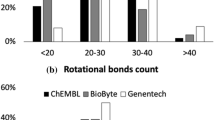Abstract
The binding of beta-lactams to human serum proteins was modeled with topological descriptors of molecular structure. Experimental data was the concentration of protein-bound drug expressed as a percent of the total plasma concentration (percent fraction bound, PFB) for 87 penicillins and for 115 β-lactams. The electrotopological state indices (E-State) and the molecular connectivity chi indices were found to be the basis of two satisfactory models. A data set of 74 penicillins from a drug design series was successfully modeled with statistics: r2=0.80, s = 12.1, q2=0.76, spress=13.4. This model was then used to predict protein binding (PFB) for 13 commercial penicillins, resulting in a very good mean absolute error, MAE = 12.7 and correlation coefficient, q2=0.84. A group of 28 cephalosporins were combined with the penicillin data to create a dataset of 115 beta-lactams that was successfully modeled: r2=0.82, s = 12.7, q2=0.78, spress=13.7. A ten-fold 10% leave-group-out (LGO) cross-validation procedure was implemented, leading to very good statistics: MAE = 10.9, spress=14.0, q2 (or r2 press)=0.78. The models indicate a combination of general and specific structure features that are important for estimating protein binding in this class of antibiotics. For the β-lactams, significant factors that increase binding are presence and electron accessibility of aromatic rings, halogens, methylene groups, and =N– atoms. Significant negative influence on binding comes from amine groups and carbonyl oxygen atoms.
Similar content being viewed by others
References
Foye, W.O. Principles of Medicinal Chemistry, 3rd Edition, Lea and Febiger, Philadelphia (1998) 33.
Prentis, R.A., Lis Y., Walker, S.R., Br. J. Clin. Pharmacol., 25 (1988) 387-396
Kennedy, T., Drug Discov. Today, 2(10) (1997) 436-444
Frostell-Karlsson, A., Ramaeus, A., Roos, H., Andersson, K., Borg, P., Hamalainen, M. and Karlsson, R., J. Med. Chem., 43 (2000) 1986.
Rolinson, G.N. and Sutherland, R., Br. J. Pharmac. Chemother. 25 (1965) 638.
Bird, A.E., Marshall A.C., Biochem. Pharmacol., 16 (1967) 2275.
Hardman, J.G. and Limbird, L.E. (Eds.) Goodman and Gilman's The Pharmacological Basis of Therapeutics, 9th Edition, McGraw-Hill Publications, New York (1996) appendix
Kier, L.B. and Hall, L.H., Molecular Connectivity In Chemistry and Drug Research. Academic Press, New York (1976)
Kier, L.B. and Hall, L.H., Molecular Connectivity in StructureActivity Analysis. John Wiley Publications, London (1986)
Hall, L.H., Kier, L.B., The Molecular Connectivity Chi Indexes and Kappa Shape Indexes in Structure-Property Relations, in Reviews of Computational Chemistry, Chap. 9, 367-422, eds. Donald Boyd and Ken Lipkowitz, VCH Publishers, Inc. 1991.
Hall, L.H., Kier, L.B., In Devillers, J. and Balaban, A.T. (Eds.), Molecular Connectivity Chi Indices for Database Analysis and Structure-Property Modeling, in Topological Indices and Related Descriptors in QSAR and QSPR, Gordon and Breach, Reading, UK, 1999, pp. 307-360.
Hall, L.H., Kier, L.B. The Molecular Connectivity Chi Indexes and Kappa Shape Indexes in Structure-Property Modeling. In Lipkowitz, K.B. and Boyd, D.B. (Eds.) Reviews of Computational Chemistry, VCH Publ., N.Y., 1991.
Kier, L.B., Hall, L.H., In Devillers, J. and Balaban, A.T. (Eds.), The Kappa Indices for Modeling Molecular Shape and Flexibility, in Topological Indices and Related Descriptors in QSAR and QSPR, Gordon and Breach, Reading, UK, 1999, pp. 455-490.
Kier, L.B. and Hall, L.H., Molecular Structure Description: The Electrotopological State, Academic Press, San Diego, (1999)
Hall, L.H.; Kier, L.B. In Devillers J. and Balaban, A.T. (Eds.) The Electrotopological State: Structure Modeling for QSAR and Database Analysis, in Topological Indices and Related Descriptors in QSAR and QSPR, Gordon and Breach, Reading, UK, 1999, 491-562.
Hall, L.H., Mohney, B.K., Kier, L.B. Quant. Struct.-Act. Relat., 12 (1993) 44-48.
Kier, L.B., Hall, L.H. Med. Chem. Res., 2 (1992) 497-502.
MDL QSARTM, MDL-SciVision, 200 Wheeler Road, Burlington MA.
Maw, H.H., Hall, L.H., J. Chem. Inf. Comput. Sci., 40 (2000) 1270-1275.
Maw, H.H., Hall, L.H., J. Chem. Inf. Comput. Sci., 41 (2001) 1248-1254.
Maw, H.H.; Hall, L.H. J. Chem. Inf. Comput. Sci., 42 (2002) 290-298.
Hall, L.H., Kier, L.B., J. Pharm. Sci., 67 (1978) 1743-1747.
Hall, L.H., Kier, L.B., J. Pharm. Sci., 67 (1978) 1408-1412.
Kier, L.B., Hall, L.H., J. Med. Chem. 20 (1977) 1631-1636.
Gough, J.D., Hall, L.H., J. Chem. Inf. Comput. Sci., 39 (1999) 356-361.
Author information
Authors and Affiliations
Rights and permissions
About this article
Cite this article
Hall, L.M., Hall, L.H. & Kier, L.B. QSAR modeling of β-lactam binding to human serum proteins. J Comput Aided Mol Des 17, 103–118 (2003). https://doi.org/10.1023/A:1025309604656
Issue Date:
DOI: https://doi.org/10.1023/A:1025309604656




